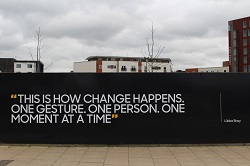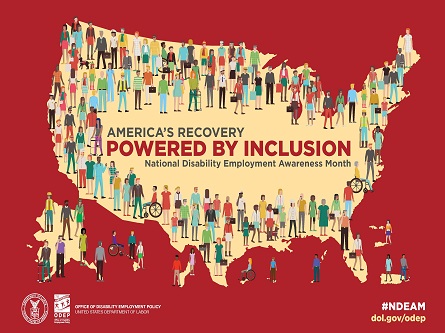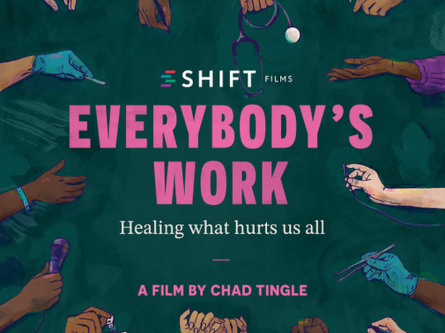"I believe it's our responsibility to show our communities the value of all people, to celebrate different, and to take a stand for acceptance and inclusion."—Julie Foudy
By Carolyn Ramirez, MA
Chair, DiversABILITY Employee Resource Group
Have you ever felt judged for looking or acting a certain way? Or perhaps the opposite – for not acting or looking a certain way?
My guess is that you have experienced something like this at least once, if not multiple times, in your life. It stings when that happens, doesn’t it? Unfortunately, people with disabilities are all too familiar with feeling judged, oftentimes before they even have a chance to wave hello or offer a warm smile.
According to the Centers for Disease Control and Prevention (CDC), more than 60 million adults in the U.S. – approximately 26% of the adult population, one of every four – live with a type of disability (e.g., affecting mobility, cognition, hearing, vision and more).
If you apply that percentage to our health system – which encompasses approximately 19,000 adults – more than 4,500 individuals (i.e., faculty, students and staff combined) could be living with a visible or hidden disability within our own UC Davis Health community. That’s a lot of people!
What’s more, it is not uncommon for people with disabilities to not self-identify as such. Why would a person do that? Well, it could be a variety of reasons. Maybe the individual doesn’t know they have a disability. Perhaps they’ve shared with a former manager that they have a disability – and the reaction was so overwhelmingly negative that they vowed to never tell anyone else at work, for fear of being treated differently than their non-disabled colleagues. There are many barriers to overcome when living with a disability, and it can be particularly tricky to navigate when gender and ethnicity are at play, especially since some cultures have conflicting views about people with disabilities.
This October happens to be National Disability Employment Awareness Month (NDEAM). It’s a good time to remind employers about the importance of inclusive hiring practices, and for all of us – including managers and supervisors – to think about how we can be better allies for people with disabilities.
Since many of us are hosting virtual meetings these days, it’s important to think about how to create an inclusive environment in a virtual setting. Below are some examples of how we can create an all-encompassing atmosphere that benefit both employees with and without disabilities:
- Ensure your audio is clear and reduce any background noise. Poor audio quality can make it hard for people to access the event.
- Enunciate clearly, as best you can, when speaking. Many vowels and consonants sound the same (e.g., think, thing, sink), making it sometimes difficult to understand what is being said.
- Provide closed captions whenever possible. Captions benefit everyone.
- Make sure you have adequate (preferably natural) lighting when your video is turned on. Dim lighting makes it hard for people to see you, which can be a barrier for people who are deaf or hard-of-hearing that need to read lips. On the flip side, lighting too bright can give people migraines or trigger other sensory sensitivities.
- Keep PowerPoint slides simple and not too cluttered with text or graphics. Learn more about making PowerPoint presentations accessible.
- If someone doesn’t have their video turned on, don’t make them feel bad by pointing it out – especially in a group setting. Assume the individual has their camera turned off for a genuine reason.
- Send meeting agendas to participants at least one business day (preferably more) in advance. Providing an agenda last-minute can create anxiety for employees, especially for those who have a disability.
- Provide breaks if the meeting or event is more than one hour. Disability or not, people need opportunities to rest their eyes from the screen, move about, use the restroom, etc.

While the American with Disabilities Act (ADA) – signed into law 31 years ago – was a critical moment in our country’s history, there is still a great deal of work to do in order to truly create a safe, equitable and inclusive environment for individuals living with disabilities, especially in the workplace.
One of many inclusive and supportive workplace practices NDEAM recommends is establishing an employee resource group (ERG) for individuals with disabilities. Lucky for us, we already have one!
The DiversABILITY Employee Resource Group at UC Davis Health was re-established in 2018. Our ERG began with five people and has grown exponentially in short order. Our vision is to bring together a wide community – people with disabilities and their allies – to develop resources and provide a safe, peer-supportive environment. Our mission is to increase awareness around the strengths of people with disabilities – both visible and hidden – and their many vital contributions to the UC Davis Health community.
For me, being part of the DiversABILITY ERG is like being part of an extended family. We have a good mix of folks, drawing from various departments and backgrounds, plus a rising number of supportive allies. To learn more about our ERG, please email me at cjramirez@ucdavis.edu.
This October (and beyond), my sincere hope is that we all think about how we can create and maintain a more inclusive and supportive environment for people (especially employees) with disabilities. We must ensure that our health system’s newly emphasized values – kindness, trust and inclusion – along with efforts surrounding diversity, equity and inclusivity, apply to all employees, including those with disabilities.





